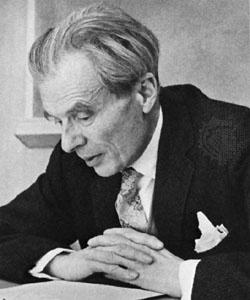Huxley, Aldous
British author
Introduction
in full Aldous Leonard Huxley
born July 26, 1894, Godalming, Surrey, Eng.
died Nov. 22, 1963, Los Angeles
 English novelist and critic gifted with an acute and far-ranging intelligence. His works were notable for their elegance, wit, and pessimistic satire.
English novelist and critic gifted with an acute and far-ranging intelligence. His works were notable for their elegance, wit, and pessimistic satire.Aldous Huxley was a grandson of the prominent biologist T.H. Huxley and was the third child of the biographer and man of letters Leonard Huxley. He was educated at Eton, during which time he became partially blind owing to keratitis. He retained enough eyesight to read with difficulty, and he graduated from Balliol College, Oxford, in 1916. He published his first book in 1916 and worked on the periodical Athenaeum from 1919 to 1921. Thereafter he devoted himself largely to his own writing and spent much of his time in Italy until the late 1930s, when he settled in California.
Huxley established himself as a major author in his first two published novels, Crome Yellow (1921) and Antic Hay (1923); these are witty and malicious satires on the pretensions of the English literary and intellectual coteries of his day. Those Barren Leaves (1925) and Point Counter Point (1928) are works in a similar vein. Huxley's deep distrust of 20th-century trends in both politics and technology found expression in Brave New World (1932), a nightmarish vision of a future society in which psychological conditioning forms the basis for a scientifically determined and immutable caste system. The novel Eyeless in Gaza (1936) continues to shoot barbs at the emptiness and aimlessness experienced in contemporary society, but it also shows Huxley's growing interest in Hindu philosophy and mysticism as a viable alternative. Many of his subsequent works reflect this preoccupation, notably The Perennial Philosophy (1946).
Huxley's most important later works are The Devils of Loudun (1952), a brilliantly detailed psychological study of a historical incident in which a group of 17th-century French nuns were allegedly the victims of demonic possession; and The Doors of Perception (1954), a book about Huxley's experiences with the hallucinogenic drug mescaline. The author's lifelong preoccupation with the negative and positive impacts of science and technology on 20th-century life make him one of the representative writers and intellectuals of that century.
Major Works
The Defeat of Youth (1918); Limbo (1920); Crome Yellow (1921); Antic Hay (1923); Jesting Pilate (1926); Point Counter Point (1928); Brave New World (1932); Eyeless in Gaza (1936); Grey Eminence (1941); The Perennial Philosophy (1946); Ape and Essence (1949); The Doors of Perception (1954); Collected Essays (1958); Literature and Science (1963).
Additional Reading
Studies of the author's life include Ronald W. Clark, The Huxleys (1968); and Sybille Bedford, Aldous Huxley: A Biography (1974). David Bradshaw (ed.), The Hidden Huxley: Contempt and Compassion for the Masses, 1920–36 (1994), is a collection of Huxley's writing that gives a fascinating insight into the contradictions in his thought. V.M. Clark, Aldous Huxley and Film (1987), provides a useful account of Huxley's attitude toward cinema and of his career in Hollywood.
- Claude-Jean Allouez
- Claude-Joseph-Désiré Charnay
- Claude Joseph Goldsmid Montefiore
- Claude-Joseph Rouget de Lisle
- Claudel, Camille
- Claude Le Jeune
- Claude Lelouch
- Claude Lorrain
- Claude Lorrain glass
- Claude-Louis Berthollet
- Claude-Louis, comte de Saint-Germain
- Claude-Louis-Hector, duc de Villars
- Claude-Louis-Hector Villars, duc de
- Claude-Louis Mathieu
- Claude-Louis Saint-Germain, comte de
- Claudel, Paul
- Claude Lévi-Strauss
- Claude Mauriac
- Claude McKay
- Claude Monet
- Claude-Nicolas Ledoux
- Claude Of France
- Claude Pajon
- Claude Pepper
- Claude Perrault